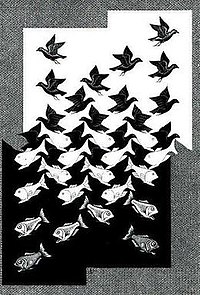
Maurits Cornelis Escher was a Dutch graphic artist who made mathematically inspired woodcuts, lithographs, and mezzotints. Despite wide popular interest, Escher was for most of his life neglected in the art world, even in his native Netherlands. He was 70 before a retrospective exhibition was held. In the late twentieth century, he became more widely appreciated, and in the twenty-first century he has been celebrated in exhibitions around the world.

The Penrose triangle, also known as the Penrose tribar, the impossible tribar, or the impossible triangle, is a triangular impossible object, an optical illusion consisting of an object which can be depicted in a perspective drawing, but cannot exist as a solid object. It was first created by the Swedish artist Oscar Reutersvärd in 1934. Independently from Reutersvärd, the triangle was devised and popularized in the 1950s by psychiatrist Lionel Penrose and his son, prominent Nobel Prize-winning mathematician Sir Roger Penrose, who described it as "impossibility in its purest form". It is featured prominently in the works of artist M. C. Escher, whose earlier depictions of impossible objects partly inspired it.

Still Life with Spherical Mirror is a lithography print by the Dutch artist M. C. Escher first printed in November 1934. It depicts a setting with rounded bottle and a metal sculpture of a bird with a human face seated atop a newspaper and a book. The background is dark, but in the bottle can be seen the reflection of Escher's studio and Escher himself sketching the scene.

Regular Division of the Plane is a series of drawings by the Dutch artist M. C. Escher which began in 1936. These images are based on the principle of tessellation, irregular shapes or combinations of shapes that interlock completely to cover a surface or plane.

Still Life and Street is an unusual woodcut print by the Dutch artist M. C. Escher which was first printed in March, 1937. It was his first print of an impossible reality. In this artwork there are two distinctly recognizable realities bound together in a natural yet impossible way. Looked at from the window, the houses make book-rests between which tiny dolls are set up. Looked at from the street, the books stand yards high and a gigantic tobacco jar stands at the crossroads.

Metamorphosis II is a woodcut print by the Dutch artist M. C. Escher. It was created between November, 1939 and March, 1940. The print measures 19.2 by 389.5 centimetres and was printed from 20 blocks on 3 combined sheets. Metamorphosis II is a long, horizontal piece which depicts animals and other forms gradually transforming into each other.

Reptiles is a lithograph print by the Dutch artist M. C. Escher first printed in March 1943. It touches on the theme found in much of his work of mathematics in art.

Puddle is a woodcut print by the Dutch artist M. C. Escher, first printed in February 1952.
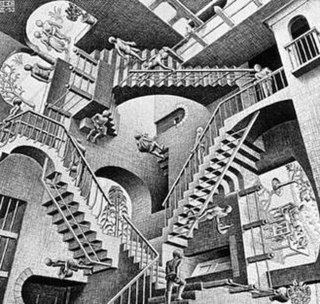
Relativity is a lithograph print by the Dutch artist M. C. Escher, first printed in December 1953. The first version of this work was a woodcut made earlier that same year.
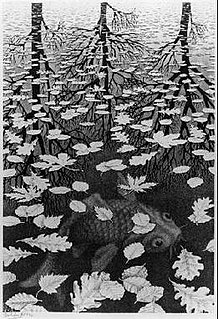
Three Worlds is a lithograph print by the Dutch artist M. C. Escher first printed in December 1955.
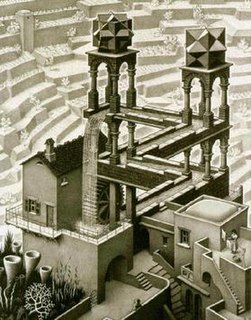
Waterfall is a lithograph by the Dutch artist M. C. Escher, first printed in October 1961. It shows a perpetual motion machine where water from the base of a waterfall appears to run downhill along the water path before reaching the top of the waterfall.

Snakes is a woodcut print by the Dutch artist M. C. Escher. The work was first printed in July 1969, and was Escher's last print before his death.
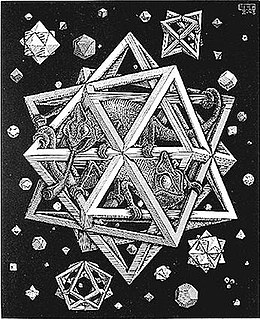
Stars is a wood engraving print created by the Dutch artist M. C. Escher in 1948, depicting two chameleons in a polyhedral cage floating through space.

The Droste effect, known in art as an example of mise en abyme, is the effect of a picture recursively appearing within itself, in a place where a similar picture would realistically be expected to appear. This produces a loop which mathematically could go on forever, but in practice only continues as far as the image's resolution allows.

Escher in Het Paleis is a museum in The Hague, Netherlands, featuring the works of the Dutch graphical artist M. C. Escher. It is housed in the Lange Voorhout Palace since November 2002.
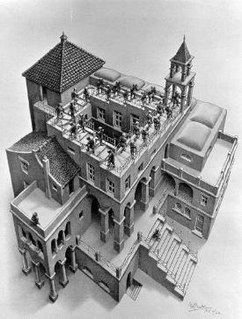
Ascending and Descending is a lithograph print by the Dutch artist M. C. Escher first printed in March 1960.
There are numerous references to Dutch painter M.C. Escher in popular culture.

Sky and Water I is a woodcut print by the Dutch artist M. C. Escher first printed in June 1938. of this print is a regular division of the plane consisting of birds and fish. Both prints have the horizontal series of these elements—fitting into each other like the pieces of a jigsaw puzzle—in the middle, transitional portion of the prints. In this central layer the pictorial elements are equal: birds and fish are alternately foreground or background, depending on whether the eye concentrates on light or dark elements. The birds take on an increasing three-dimensionality in the upward direction, and the fish, in the downward direction. But as the fish progress upward and the birds downward they gradually lose their shapes to become a uniform background of sky and water, respectively.

Print Gallery is a lithograph printed in 1956 by the Dutch artist M. C. Escher. It depicts a man in a gallery viewing a print of a seaport, and among the buildings in the seaport is the very gallery in which he is standing, making use of the Droste effect with visual recursion. The lithograph has attracted discussion in both mathematical and artistic contexts. Escher considered Print Gallery to be among the best of his works.

Double Planetoid is a wood engraving print by the Dutch artist M. C. Escher, first printed in 1949.
